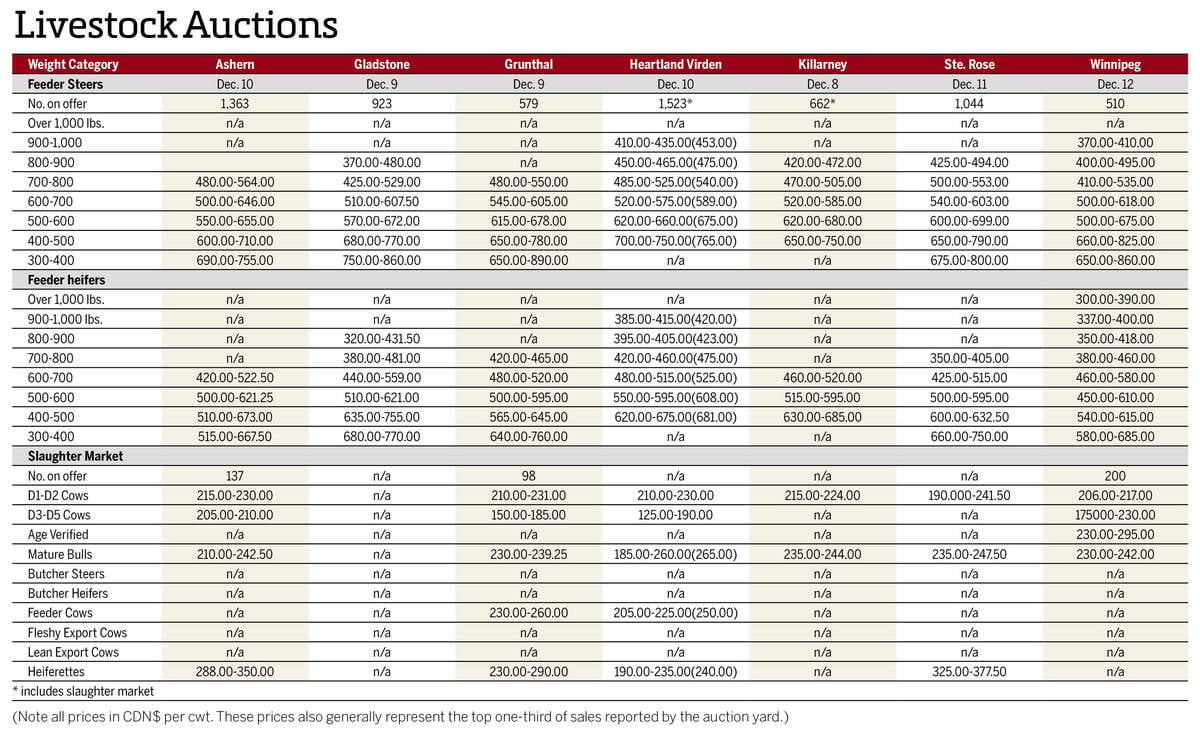ICE Futures Canada canola contracts fell to their lowest levels in more than six months on April 3, but bounced off those lows and were higher overall by the close on April 7.
A bearish reaction to the U.S. Department of Agriculture’s prospective plantings and quarterly stocks reports sent soybeans in a tailspin lower, and that selling spilled into canola. Soybeans received added pressure from the advancing South American harvest and the consistently rising production estimates out of the continent.
USDA forecast U.S. soybean seedings this year at a record 89.5 million acres, which would be up from 83.4 million in 2016. In addition, old-crop stocks as of March 1, at 1.73 billion bushels, were considered large.
Read Also

Manitoba cattle prices Dec. 16
Here’s what local farmers were getting paid last week for their cattle at Manitoba livestock auction marts; prices covering the week Dec. 8-12, 2025.
While the big-picture issues of big world oilseed supplies may cast a bearish pall over the canola market, the commodity still has a few supportive influences of its own.
Demand remains very strong, with both exporters and domestic crushers running well ahead of the year-ago level. At the same time, supplies are tightening, with market participants still unsure just how much canola that was left to overwinter across the Prairies will be salvaged.
Statistics Canada releases its own acreage projections on April 20, and early trade guesses place canola acres at anywhere from about 20 million to 22 million acres. That would compare with the 20.4 million acres seeded to the crop in 2016.
The seasonal uncertainty ahead of spring seeding should keep canola relatively rangebound over the next few weeks, until market participants get a better handle on the new-crop situation.
From a chart standpoint, the May canola contract hit a six-month low of $473.70 on April 3. On the other side, the psychological $500-per-tonne level marks a nearby upside target.
In the U.S., May soybeans touched a contract low of US$9.365 per bushel during the week, but managed to consolidate right above that level. The path of least resistance likely remains pointed lower for soybeans, with the weekly charts suggesting a move to US$9 or lower is possible. On the other side, if there is a corrective bounce, US$9.50 should provide nearby resistance, with the next upside target at US$10.
Corn futures trended lower during the week, as an initial bullish reaction to USDA’s acreage report gave way to ideas that actual corn seedings may not end up as small as the government agency reported.
USDA forecast U.S. corn acres in 2017 at just under 90 million, which would be down significantly from the 94 million acres seeded in 2017. However, there is still time to swing some area from beans into corn.
Wheat, meanwhile, is looking at record-low acres in the U.S. However, improving crop conditions across most of the winter wheat-growing regions of the country kept prices trending lower in all three U.S. wheat futures markets.
















